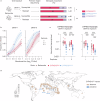Dengue virus susceptibility in Aedes aegypti linked to natural cytochrome P450 promoter variants
- PMID: 40796739
- PMCID: PMC12343897
- DOI: 10.1038/s41467-025-62693-y
Dengue virus susceptibility in Aedes aegypti linked to natural cytochrome P450 promoter variants
Abstract
The mosquito Aedes aegypti is the primary vector for dengue virus (DENV), which infects millions of people annually. Variability in DENV susceptibility among wild Ae. aegypti populations is governed by genetic factors, but specific causal variants are unknown. Here, we identify a cytochrome P450-encoding gene (CYP4G15) whose genetic variants drive differences in DENV susceptibility in a natural Ae. aegypti population. CYP4G15 is transiently upregulated in DENV-resistant midguts, while knockdown increases susceptibility, and transgenic overexpression enhances resistance. A naturally occurring 18-base-pair promoter deletion reduces CYP4G15 expression and confers higher DENV susceptibility. The unexpected role of a cytochrome P450 in DENV susceptibility challenges the long-standing focus on canonical immune pathways and opens new avenues for understanding antiviral defense and DENV transmission in mosquitoes.
© 2025. The Author(s).
Conflict of interest statement
Competing interests: The authors declare no competing interests.
Figures




References
-
- Brady, O. J. & Hay, S. I. The global expansion of dengue: how Aedes aegypti mosquitoes enabled the first pandemic arbovirus. Annu. Rev. Entomol. 10.1146/annurev-ento-011019-024918 (2020). - PubMed
-
- Bennett, K. E. et al. Variation in vector competence for dengue 2 virus among 24 collections of Aedes aegypti from Mexico and the United States. Am. J. Trop. Med. Hyg.67, 85–92 (2002). - PubMed
-
- Gubler, D. J., Nalim, S., Tan, R., Saipan, H. & Sulianti Saroso, J. Variation in susceptibility to oral infection with dengue viruses among geographic strains of Aedes aegypti. Am. J. Trop. Med. Hyg.28, 1045–1052 (1979). - PubMed
-
- Bosio, C. F., Beaty, B. J. & Black, W. C. Quantitative genetics of vector competence for dengue-2 virus in Aedes aegypti. Am. J. Trop. Med. Hyg.59, 965–970 (1998). - PubMed
MeSH terms
Substances
Grants and funding
LinkOut - more resources
Full Text Sources
Medical

